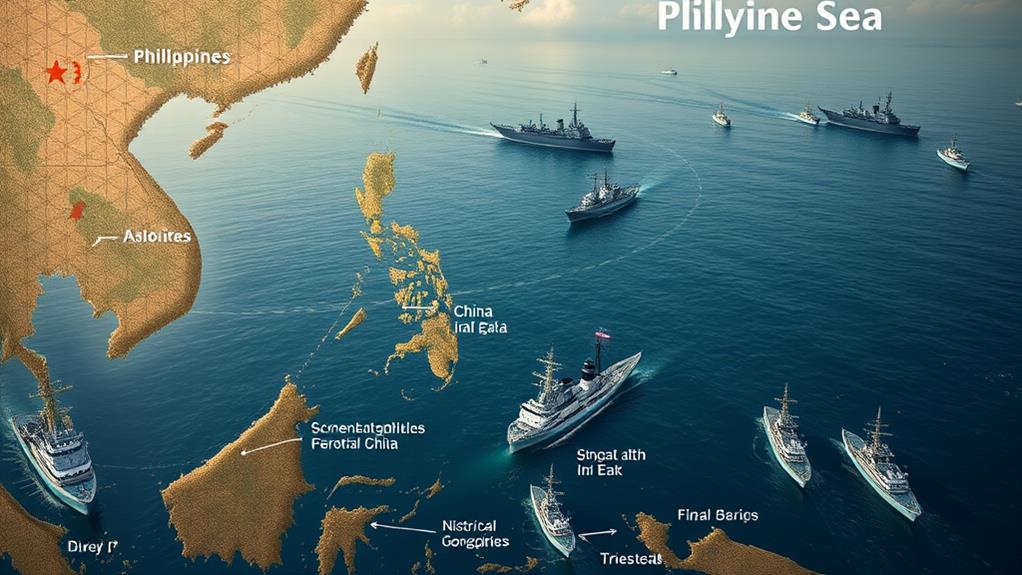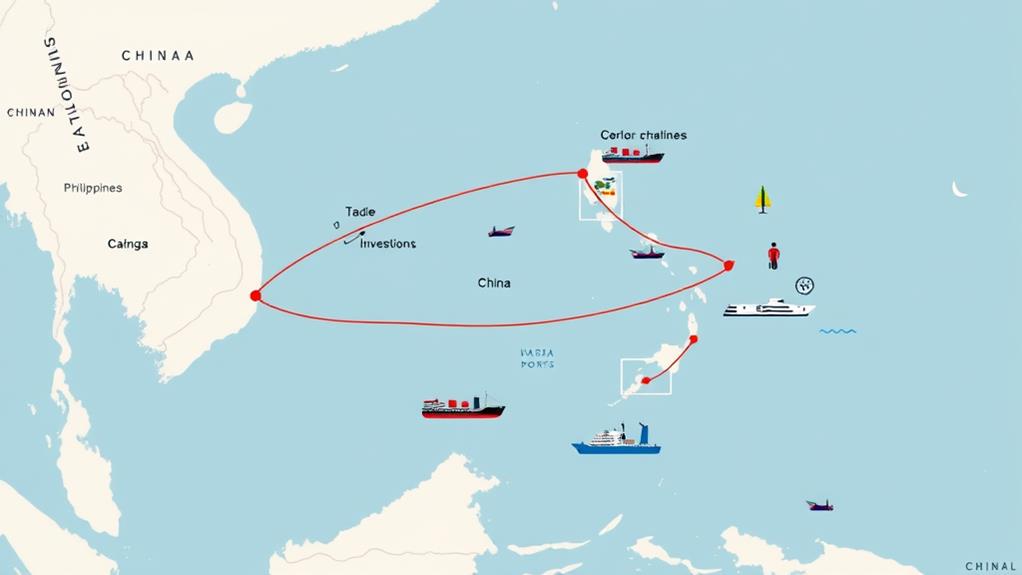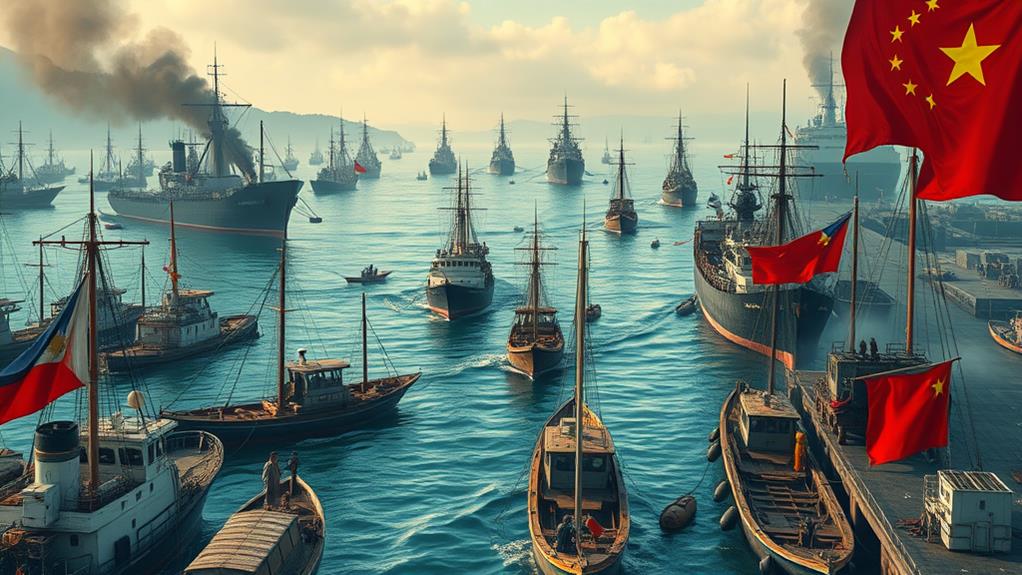The Philippines' relations with China are characterized by a delicate balance between economic cooperation and political tensions. China is the Philippines' top trading partner, with a $41 billion trade volume in 2023. This strong economic tie is overshadowed by the escalating disputes over the South China Sea, where China's nine-dash line claim encroaches on the Philippines' exclusive economic zone.
To navigate this complex situation, the current administration under Ferdinand Marcos Jr. is seeking to balance economic cooperation with the assertion of sovereignty. This involves strengthening alliances with the US and Japan to counter Chinese influence.
This strategic approach highlights the need for careful diplomatic engagement to maintain economic momentum without compromising national interests.
In the context of the South China Sea disputes, the Philippines is asserting its sovereignty by upholding its rights under the United Nations Convention on the Law of the Sea (UNCLOS). This move is crucial in protecting the country's exclusive economic zone and maritime rights.
To achieve a balance between economic cooperation and political assertiveness, the Philippines must engage in careful diplomatic negotiations with China. This involves establishing clear communication channels, setting boundaries, and promoting mutual understanding.
Ultimately, the Philippines' relations with China are a delicate balancing act. By strengthening alliances, asserting sovereignty, and engaging in careful diplomacy, the country can maintain economic momentum while protecting its national interests.
Historical Context of Relations

The historical context of relations between the Philippines and China is marked by a complex interplay of economic interdependence and territorial disputes.
The South China Sea dispute is a major point of contention, with China's nine-dash line claim encroaching upon the Philippines' exclusive economic zone (EEZ). This dispute has been ongoing for decades, with a significant development in 2016 when an international arbitral tribunal ruled against China's claims.
China has refused to acknowledge the ruling, leading to continued tensions.
The Philippines' approach to China has been divided historically. During Rodrigo Duterte's presidency, the country adopted a Beijing-friendly stance, seeking economic benefits while downplaying territorial issues. This approach led to internal political divisions, with some officials and politicians arguing for a more assertive stance against Chinese aggression.
The current administration under President Ferdinand Marcos Jr faces a delicate challenge: balancing economic ties with China, its top trading partner, while asserting Philippine sovereignty and maritime rights.
This challenge is further complicated by the country's strengthening alliances with the US and Japan, aimed at countering Chinese influence in the region.
Economic Interdependence
Economic Interdependence between the Philippines and China
The Philippines and China have significant trade relations, making it crucial to navigate their economic interdependence. Despite tensions in the South China Sea, their economic ties remain robust.
Trade Volume and Composition
China is the Philippines' top trading partner, with a combined trade volume of $41 billion in 2023. The Philippines exports goods such as digital monolithic integrated circuits and nickel ores to China, while importing petroleum lubricants and components for semiconductor devices.
Investment Projects
Key infrastructure projects between the two nations include the Chico River Pump Irrigation Project, the Kaliwa Dam Project, and the North-South Railway Project.
Challenges and Opportunities
The Philippines faces risks of economic coercion from China, but also sees opportunities for trade and investment as a way to foster better understanding and cooperation.
Benefits of Economic Interdependence
These economic engagements create mutual benefits, fostering trust and cooperation despite political tensions.
For instance, during President Ferdinand Marcos Jr.'s visit to China in 2023, the two countries signed 14 bilateral trade agreements, emphasizing areas like information and communications technology and agriculture.
This economic interdependence incentivizes both nations to maintain stable relations, which can help manage disputes through dialogue rather than hostility.
However, the Philippines must also diversify its trading partners to mitigate the risk of economic coercion by China.
South China Sea Disputes

The Philippines is at the forefront of a complex geopolitical standoff with China in the South China Sea. This dispute revolves around China's expansive claims, marked by the nine-dash line, which encroach upon the Philippines' exclusive economic zone (EEZ). For instance, China has fired water cannons at Philippine boats on resupply missions and forcibly boarded Philippine navy vessels.
Historical trade routes have played a crucial role in the region. The South China Sea has long been a vital passageway for international trade, much like the Pasig River's vital artery served as a crucial lifeline for goods and communication in the region.
The Philippines is navigating these challenges while balancing economic ties with China. President Ferdinand Marcos Jr.'s administration is committed to asserting its maritime rights, often with the support of allies like the United States and Japan.
The strategic importance of the South China Sea amplifies the stakes.
To mitigate these tensions, the Philippines has established communication mechanisms. A hotline with China has been set up, although its effectiveness has been questioned given China's non-responsiveness during critical incidents.
The country's reliance on alliances and adherence to a rules-based order are becoming key strategies.
US and Japan Partnerships
The Philippines Strengthens Alliances with the US and Japan
The administration of President Ferdinand Marcos Jr. is reinforcing its alliances with the United States and Japan to counterbalance China's growing presence in the South China Sea.
This strategic move aims to bolster the Philippines' position in the region while leveraging economic benefits.
Economic Development and Natural Resources
The Philippines is rich in natural resources, which play a crucial role in its economic development.
The country's geological history, including significant volcanic eruptions like Mount Pinatubo, showcases its natural wealth.
US Commitments to the Philippines
At a recent White House summit, US President Joe Biden reaffirmed the US's ironclad defense commitments to the Philippines.
Any attack on Philippine vessels or armed forces in the South China Sea would invoke the Mutual Defense Treaty.
Trilateral Partnership
The partnership between the US, Japan, and the Philippines is multifaceted, combining security assurances with economic development.
The US has pledged to assist the Philippines in developing key sectors such as semiconductors, telecommunications, and critical infrastructure.
For example, the creation of the Luzon Economic Corridor will connect Manila to strategic areas like the former Subic naval base and Clark airbase, making the Philippines an attractive alternative for US semiconductor manufacturers.
Trade and Investment Dynamics

The Philippines Prioritizes Economic Ties with China
Despite escalating tensions in the South China Sea, the Philippines remains committed to maintaining economic ties with China. This complex relationship is reminiscent of historical trade routes, where economic exchanges shaped regional relationships.
Economic Significance of Trade with China
China is the Philippines' top trading partner, with combined exports and imports totaling $41 billion in 2023. This significant economic relationship highlights the importance of sustaining trade and investment links, even amidst geopolitical tensions.
Balancing Economic Cooperation and Sovereignty
The Philippines must navigate the risks associated with deepening economic ties with China while ensuring that these engagements don't compromise its sovereignty or territorial claims in the South China Sea.
This delicate balance is crucial as the country seeks to leverage economic benefits without succumbing to political pressures that could undermine its national interests.
Challenges in Diplomatic Relations
Navigating Complex Diplomatic Relations
Maintaining diplomatic relations between the Philippines and China is a highly complex and challenging task, particularly due to the escalating tensions in the South China Sea. China's disputed nine-dash line encroaches on the exclusive economic zones of other claimants, including the Philippines. The region's historical significance as a vital trade route adds layers to these tensions, influencing economic interactions and territorial claims.
Recent Incidents Expose Divisions
Recent incidents have highlighted the deepening rifts in these relations. For instance, a skirmish near the Second Thomas Shoal exposed significant divisions within the Philippine government regarding how to handle China's assertiveness.
Some officials dismissed the incident as a misunderstanding, while others condemned it as an aggressive and illegal use of force.
Balancing Diplomatic Engagement and Sovereignty
The Philippines is committed to engaging in confidence-building measures with China to manage these tensions, but any such efforts mustn't compromise the assertion of Philippine sovereignty and jurisdiction over the West Philippine Sea.
The complexity is further compounded by the need to balance diplomatic engagement with China while fostering stronger ties with other nations, such as the United States and Japan, to counteract Chinese influence.
This delicate balance underscores the strategic and diplomatic challenges in maintaining stable relations with China.
How do the economic ties and political tensions between the Philippines and China compare to those with other neighboring countries such as Indonesia, Malaysia, and Taiwan?
The economic ties and political tensions between the Philippines and China differ from those with the philippines’ neighboring countries. While the Philippines has ongoing disputes with China over the South China Sea, its relations with Indonesia, Malaysia, and Taiwan are generally less contentious, with a focus on economic cooperation.
Impact on Bilateral Trade

The escalating tensions between the Philippines and China in the South China Sea significantly impact their bilateral trade relations.
China remains the Philippines' largest trading partner, with substantial economic ties between the two nations.
Trade Volume: The total trade between the Philippines and China amounts to $41 billion (2023).
Major Trading Partners: The Philippines' top trading partners are China (1st), Japan (2nd), and the US (3rd). China's key exports to the Philippines include electronics, machinery, and textiles.
Economic Dependence: The Philippines has a high dependence on Chinese imports. In return, China has made significant investments in Philippine infrastructure.
Future Outlook: The Philippines' alignment with the US and Japan may lead to a potential decline in Chinese investment. Despite political tensions, China maintains a continued interest in the Philippine market.
The Philippine government strives to balance its economic relationships with China and other countries like the US and Japan.
Maintaining economic ties with all countries, including China, is crucial to sustaining economic momentum, according to the Philippines' economic planning chief, Arsenio Balisacan.
This delicate balance is essential in navigating the complex landscape of bilateral trade amidst rising geopolitical tensions.
Future Prospects and Strategies
The Philippines must strike a balance between economic cooperation with China and asserting its sovereignty in the South China Sea.
To achieve this balance, the Philippines will need to diversify its economic partnerships, including strengthening ties with the US and Japan, to reduce its dependence on China. This strategy will involve seeking economic benefits from multiple sources, ensuring that the country isn't overly reliant on a single partner.
The Philippines can draw inspiration from its rich history as a trade hub, with waterways like the Pasig River having facilitated commerce and cultural exchange in the past. This historical significance can be leveraged to attract investments and trade partnerships from various countries.
Mitigating military conflicts is crucial, and the Philippine government is likely to emphasize economic cooperation and confidence-building measures with China. Recent efforts, such as working group sessions aimed at resolving disputes through the Bilateral Consultation Mechanism, demonstrate this approach.
However, any negotiations must ensure that Philippine sovereignty isn't compromised.
Diversification of investments and trade partnerships is key. For instance, the Philippines is positioning itself as a viable alternative for US semiconductor manufacturers, leveraging its strategic location and young workforce. This approach helps maintain economic momentum while navigating the complex geopolitical terrain.
Ultimately, the Philippines' future prospects hinge on its ability to engage in diplomatic efforts that preserve its rights while fostering economic growth. By adopting a balanced and diversified approach, the country can navigate its complex relationship with China and ensure a prosperous future.
Questions and Answers
How Do Local Filipino Communities Perceive the South China Sea Disputes?
Local Filipino communities are deeply concerned about the South China Sea disputes. This concern stems from the perception of China as a significant threat, with 76% of Filipinos identifying China as the country's greatest threat.
The primary reasons for this apprehension are fears of armed conflict and China's increasing assertiveness in the region.
Historical incidents, such as the Scarborough Shoal standoff, have contributed to this fear. Ongoing harassment by Chinese Coast Guard vessels also fuels the apprehension.
As a result, the public sentiment in the Philippines emphasizes the need for legal mechanisms and diplomatic resolve to address the disputes.
What Role Do Other Southeast Asian Countries Play in Mediating the Disputes?
Other Southeast Asian countries play a vital role in mediating South China Sea disputes. These nations, particularly those in the Association of Southeast Asian Nations (ASEAN), promote a regional approach to conflict resolution. They focus on preventive diplomacy and cooperative security to manage tensions and promote dialogue.
Vietnam, Malaysia, and Brunei, as claimants, engage in collective efforts through ASEAN forums to avoid escalation and seek stability in the region.
For instance, ASEAN has established the East Asia Summit, a forum that brings together leaders from ASEAN member states and other regional partners to discuss security issues, including the South China Sea disputes.
Additionally, ASEAN has implemented the Code of Conduct, a set of guidelines aimed at promoting maritime cooperation and preventing conflicts in the region.
How Has Public Opinion in the Philippines Shifted on China Relations?
A significant shift in public opinion in the Philippines has occurred, with a growing distrust of China.
In recent times, 76% of Filipinos have come to view China as the greatest threat to their country. This perception is fueled by escalating maritime tensions and confrontations in the South China Sea.
91% of Filipinos now distrust China, a substantial increase from 58% since President Marcos Jr.'s term began.
The negative sentiment is further reinforced by the fact that only 13% of Filipinos believe China has a positive impact on their country.
What Are the Environmental Impacts of the South China Sea Conflicts?
Environmental degradation is a severe consequence of the South China Sea conflicts. China's island-building activities have resulted in the destruction of over 100 square miles of coral reefs, disrupting ecosystems and fish migration patterns.
This destruction has a ripple effect on the entire ecosystem, as coral reefs are essential habitats for numerous marine species.
Overfishing is another significant environmental issue. China's large fleet has contributed to the depletion of fish stocks, with a reduction of 70-90%.
This not only affects the marine ecosystem but also the livelihoods of millions of people who depend on fishing and related industries.
Climate change and pollution further exacerbate the environmental threats. Coral reefs, which are already vulnerable to destruction, suffer significantly from the warming of ocean temperatures and pollution.
The combined impact of these human activities and natural disasters imperils the ecological future of the region.
How Do Chinese Investments Affect Local Employment in the Philippines?
Chinese investments in the Philippines have a dual impact on local employment.
On the one hand, these investments generate jobs in construction and infrastructure during project phases, benefiting local workers. For instance, the Philippine government's "Build, Build, Build" program, which is heavily backed by Chinese funding, has created thousands of jobs in the construction sector.
On the other hand, the influx of Chinese workers raises concerns about job displacement and unequal wages. Many Chinese workers are employed in projects, taking jobs that could have gone to Filipinos. This exacerbates local employment issues and social tensions.
For example, in 2020, the Philippine Department of Labor and Employment reported that over 45,000 Chinese nationals were working in the country, sparking concerns about the impact on local job opportunities.